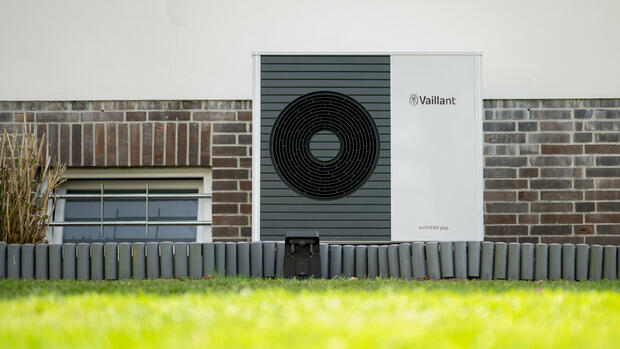Berlin The municipal utility is convinced that heating networks can play a key role in heating in the future – and save many owners expensive investments in a heat pump. “We consider it conceivable that district heating’s market share will triple from today’s 14 percent by 2045,” said Ingbert Liebing, Managing Director of the Association of Municipal Companies (VKU), the Handelsblatt.
The municipal utilities, which have a market share of 90 percent in the heating networks, are combined in the VKU. Six out of 43 million households in Germany are currently supplied with district heating.
The federal government wants to strengthen the role of the heating networks and has therefore invited to the district heating summit today. The topic plays a role in the debate about the amendment to the Building Energy Act (GEG).
The GEG draft, which Economics Minister Robert Habeck (Greens) and Building Minister Klara Geywitz (SPD) brought through the cabinet in April, stipulates that from 2024 every newly installed heating system should be operated with 65 percent renewable energies.
Heating networks are also to gradually become greener in the coming years. By 2030, they should have at least 50 percent heat from renewable energies or waste heat, and by 2045 they must be completely climate-neutral.
Homeowners would not have to install a new heating insert
For homeowners, the connection to a heating network makes the installation of a new heating system superfluous. Instead of switching to heating with renewable energies yourself, you can delegate this task to the operator of the heating network and avoid investing in a heat pump. “With heating networks, there is the possibility of suddenly converting entire residential districts to a climate-friendly heat supply,” says Liebing.
The federal government promotes the expansion of heating networks with the “Federal Funding for Efficient Heating Networks” (BEW) program. The program was launched in mid-September last year. It is endowed with three billion euros and runs until 2026.
VKU boss Liebing describes the program as a “positive signal”, but is convinced that the funds are “far from enough”.
“The expansion of heating networks is “extremely capital-intensive,” he said. “We need three billion euros a year until 2035”. He suggests providing the money from the Climate and Transformation Fund (KTF).
The expansion of heating networks is closely linked to municipal heating planning, which the federal government wants to promote with its own law. This should oblige the municipalities to define areas that are suitable for heating networks.
>> Read here: Plumbers refuse orders to install gas boilers
On the basis of a potential analysis, they should then define a target image with concrete implementation plans. So far there has only been mandatory municipal heating planning in Germany, for example in Baden-Württemberg.
Kerstin Andreae, General Manager of the Federal Association of Energy and Water Industries (BDEW), said it was important to create a framework that would enable both energy companies and homeowners to implement the heat transition in a planned manner. It is “essential” to strengthen district heating.
Industry converts district heating networks to more climate-friendly solutions
Liebing is therefore convinced that municipal heating plans play a central role. “The municipal utilities need the heat plans today rather than tomorrow,” he said. That is why the VKU welcomes considerations of bringing forward the obligation to submit heat plans by one year in the planned Heat Planning Act. However, this presupposes that the municipalities can create them without great effort.
The Building Energy Act is also intended to make heating networks more climate-friendly.
(Photo: dpa)
The original draft law said that large cities should have until the end of 2026 to draw up the heat plans, smaller cities until the end of 2028. The most recent version mentions 2025 and 2027. “The sooner the heat planning is available, the greater the chance of protecting homeowners from making wrong decisions,” said Liebing.
Most district heating networks are still operated on the basis of fossil fuels, for example by using the waste heat from power plants or industrial plants. Waste incinerators also serve as heat sources.
The industry is gradually switching to more climate-friendly solutions. There are already grids that are fed with geothermal energy. Large heat pumps will also play a role in the future. Existing CHP systems are also changing because they can be operated with climate-neutral hydrogen in the future.
KWK stands for combined heat and power generation. CHP plants produce electricity and heat at the same time. They are currently operated largely with natural gas.
Consumer advocates call for nationwide price control for district heating
However, many district heating offers are suspected of being overpriced. The background is that the operators of heating networks are monopoly suppliers. Anyone who has scrapped their old boiler and has it connected to the heating network usually has to be contractually bound for many years and has hardly any options to switch.
The German Tenants’ Association (DMB) and the Federal Association of Consumer Organizations (vzbv) are therefore calling for improved consumer and tenant protection when expanding district heating. This is the only way to create broad acceptance among the population and for district heating to make its contribution to the heat transition, according to a joint demand paper by DMB and vzbv.
>> Read here: How to install a heat pump inconspicuously
Vzbv board member Ramona Pop said: “Lack of transparency and incomprehensible price increases lead to skepticism or even rejection of district heating.” This is where the legislator has to get involved. Melanie Weber-Moritz, Federal Director of the DMB, called for a “nationwide price supervision” that systematically examines and regulates the prices and their composition.
More: Heating law turns waste incineration into renewable energy

